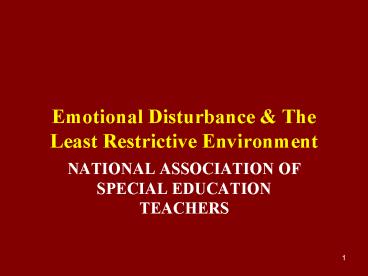Emotional Disturbance - PowerPoint PPT Presentation
Title:
Emotional Disturbance
Description:
General Education/Inclusion Classroom. Resource Room. Separate Class (self-contained class) ... education classroom and the special education resource room. ... – PowerPoint PPT presentation
Number of Views:89
Avg rating:3.0/5.0
Title: Emotional Disturbance
1
Emotional Disturbance The Least Restrictive
Environment
- NATIONAL ASSOCIATION OF SPECIAL EDUCATION TEACHERS
2
Educational Placements for Students with ED
- Under IDEA, all students in special education
must be educated in the least restrictive
environment. - Least Restrictive EnvironmentThe principle under
IDEA that children in special education must be
educated with their non disabled peers to the
maximum extent appropriate
3
Educational Placements for Students with ED
- Where are students with ED being educated?
- General Education/Inclusion Classroom
- Resource Room
- Separate Class (self-contained class)
- Separate School
- Residential Facility
- Psychiatric Hospital
- Homebound/Hospital
4
General Education orInclusion Classroom
- Approximately 28 of all students classified with
an emotional disturbance receive their education
in the general education or inclusion classroom
environment - The exceptional student receives the same
academic instruction as the general education
students with individualized academic and
behavior management services as needed
5
Resource Room
- Approximately 23 of all students classified
with an emotional disturbance receive their
education in a resource room. - The exceptional student receives academic
instruction in the general education classroom
and the special education resource room. The
division of time is based on the students
individualized academic and behavioral needs
6
Special Education Classroom
- Approximately 31 of all students classified with
an emotional disturbance receive their education
in a special education classroom (Also referred
to as a self-contained classroom). - The exceptional student receives all educational
services in the special education classroom - Students who are placed in self-contained
classrooms tend to have more severe and
disruptive behaviors than students who are placed
in resource rooms
7
Separate Special Education School
- Approximately 14 of all students classified with
an emotional disturbance receive their education
in a separate special education school (also
referred to as an Alternative Day School). - The exceptional student receives all educational
services in a setting that is separate from the
regular public school. - The alternative school is specially designed for
students who have academic and/or behavioral
problems that are too severe or disruptive for
the public school setting
8
Residential Treatment Facility
- Approximately 2 of all students classified with
an emotional disturbance receive their education
in a residential treatment facility (also
referred to as a RTF or RTC (Residential
Treatment Center) - The exceptional student receives all educational
services in a residential facility providing
24-hour care for a time period normally ranging
from a few months to a year or more, depending on
the severity of the problem
9
Residential Treatment Facility
- Outdoor adventure programs are often a critical
component of certain residential treatment
programs - programs attempt to teach students with ED
thinking and decision making skills, group
cooperation, self-reliance, and social skills
combined with wilderness experiences. - Although safety considerations are always
factored in, there is a certain element of risk
involved in some of the activities, which lends
its appeal to students with ED, especially those
with serious behavioral issues.
10
Psychiatric Hospital Placement
- Approximately 1 of all students classified with
an emotional disturbance receive their education
in a psychiatric hospital placement - Individualized assessment, intervention, and
medical and educational services are provided in
a hospital setting for students with severe
psychological and/or medical problems that cannot
be managed on an outpatient basis
11
Homebound Instruction
- Approximately 1 of all students classified with
an emotional disturbance receive their education
as homebound instruction. - Individualized educational services are provided
in the students home when he/she is unable to
attend school for medical, behavioral or other
reasons
12
Final Key Point on Educational Placement
- Conclusion-Relative to other students with
disabilities, children with emotional or
behavioral disorders - . are more likely to be educated outside the
general education classroom (72 of the time, on
average - .and in almost half the cases, not educated in
the general education classroom at all, e.g.,
self-contained, alternative day school, RSF,
hospital or homebound)
13
Educational Implications of Students with
Emotional Disturbance
- School failure is the common link among students
with emotional and behavioral disorders. - Regardless of intellectual potential, students
with emotional or behavioral disorders do not
perform well academically.
14
Educational Implications of Students with
Emotional Disturbance
- As compared to students without disabilities,
students with emotional or behavioral disorders
leave school at higher rates and are placed in
more restrictive settings. - Research suggests that approximately 50 of
students with emotional and/or behavioral
disorders drop out of high school































